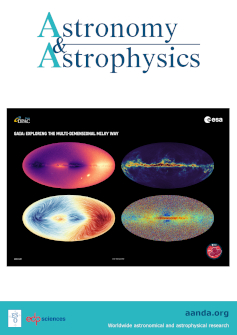Expected performance of the Pyramid wavefront sensor with a laser guide star for 40 m class telescopes
IF 5.4
2区 物理与天体物理
Q1 ASTRONOMY & ASTROPHYSICS
引用次数: 0
Abstract
Context. The use of artificial laser guide stars (LGS) is planned for the new generation of giant segmented mirror telescopes in order to extend the sky coverage of their adaptive optics systems. The LGS, being a 3D object at a finite distance, will have a large elongation that will affect its use with the Shack–Hartmann (SH) wavefront sensor.Aims. In this paper, we compute the expected performance for a Pyramid WaveFront Sensor (PWFS) using an LGS for a 40 m telescope affected by photon noise, and also extend the analysis to a flat 2D object as reference.Methods. We developed a new way to discretize the LGS, and a new, faster method of propagating the light for any Fourier filtering wavefront sensors (FFWFS) when using extended objects. We present the use of a sensitivity model to predict the performance of a closed-loop adaptive optic system. We optimized a point-source-calibrated interaction matrix to accommodate the signal of an extended object by computing optical gains using a convolutional model.Results. We find that the sensitivity drop, given the size of the extended laser source, is large enough to make the system operate in a low-performance regime given the expected return flux of the LGS. The width of the laser beam is identified as the limiting factor, rather than the thickness of the sodium layer. Even an ideal, flat LGS will have a drop in performance due to the flux of the LGS, and small variations in the return flux will result in large variations in performance.Conclusions. We conclude that knife-edge-like wavefront sensors, such as the PWFS, are not recommended for use with LGS for a 40 m telescope, as they will operate in a low-performance regime, given the size of the extended object.为 40 米级望远镜配备激光导星的金字塔波前传感器的预期性能
背景。新一代巨型分段镜望远镜计划使用人造激光导引星(LGS),以扩大其自适应光学系统的天空覆盖范围。LGS是一个距离有限的三维物体,会有很大的伸长率,这将影响其与Shack-Hartmann(SH)波前传感器的配合使用。 在本文中,我们计算了使用LGS的金字塔波前传感器(PWFS)在受光子噪声影响的40米望远镜中的预期性能,并将分析扩展到平面二维物体作为参考。我们开发了一种将 LGS 离散化的新方法,以及一种在使用扩展物体时为任何傅立叶滤波波前传感器(FFWFS)传播光线的更快的新方法。我们介绍了如何使用灵敏度模型来预测闭环自适应光学系统的性能。通过使用卷积模型计算光学增益,我们优化了点源校准交互矩阵,以适应扩展物体的信号。我们发现,考虑到扩展激光光源的尺寸,灵敏度下降的幅度很大,足以使系统在低性能状态下运行,而激光光源的预期回波通量则是如此。激光束的宽度被认为是限制因素,而不是钠层的厚度。即使是理想的平面 LGS 也会因 LGS 的通量而导致性能下降,而返回通量的微小变化也会导致性能的巨大变化。我们得出的结论是,不建议在 40 米望远镜上将刀刃式波前传感器(如 PWFS)与 LGS 配合使用,因为考虑到扩展天体的尺寸,它们将在低性能状态下运行。
本文章由计算机程序翻译,如有差异,请以英文原文为准。
求助全文
约1分钟内获得全文
求助全文
来源期刊

Astronomy & Astrophysics
地学天文-天文与天体物理
CiteScore
10.20
自引率
27.70%
发文量
2105
审稿时长
1-2 weeks
期刊介绍:
Astronomy & Astrophysics is an international Journal that publishes papers on all aspects of astronomy and astrophysics (theoretical, observational, and instrumental) independently of the techniques used to obtain the results.
 求助内容:
求助内容: 应助结果提醒方式:
应助结果提醒方式:


